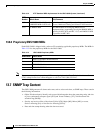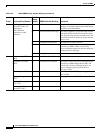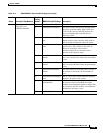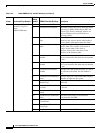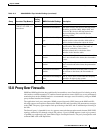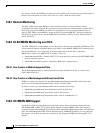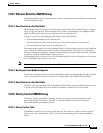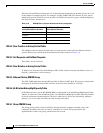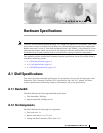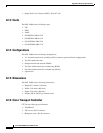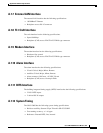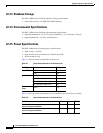
13-14
Cisco ONS 15600 Reference Manual, R7.2
Chapter 13 SNMP
13.8.5 History Control RMON Group
The historyControlTable maximum row size is determined by multiplying the number of ports on a card
by the number of sampling periods. For example, an ONS 15600 E100 card contains 24 ports, which
multiplied by periods allows 96 rows in the table. An E1000 card contains 14 ports, which multiplied by
four periods allows 56 table rows.
13.8.5.2 Row Creation in historyControlTable
The etherStats table and historyControl table are automatically created when the Ethernet facility is
created. History size is based upon the default history bucket located in Table 13-6.
13.8.5.3 Get Requests and GetNext Requests
These PDUs are not restricted.
13.8.5.4 Row Deletion in historyControl Table
To delete a row from the table, the SetRequest PDU should contain a historyControlStatus value of 4
(invalid). A deleted row can be recreated.
13.8.5.5 Ethernet History RMON Group
The ONS 15600 implements the etherHistoryTable as defined in RFC 2819. The group is created within
the bounds of the historyControlTable and does not deviate from the RFC in its design.
13.8.5.6 64-Bit etherHistoryHighCapacityTable
64-bit Ethernet history for the HC-RMON-MIB is implemented in the etherHistoryHighCapacityTable,
which is an extension of the etherHistoryTable. The etherHistoryHighCapacityTable adds four columns
for 64-bit performance monitoring data. These two tables have a one-to-one relationship. Adding or
deleting a row in one table will effect the same change in the other.
13.8.5.7 Alarm RMON Group
The Alarm group consists of the alarmTable, which periodically compares sampled values with
configured thresholds and raises an event if a threshold is crossed. This group requires the
implementation of the event group, which follows this section.
Table 13-6 RMON History Control Periods and History Categories
Sampling Periods
(historyControlValue Variable)
Total Values, or Buckets
(historyControl Variable)
15 minutes 32
24 hours 7
1 minute 60
60 minutes 24



